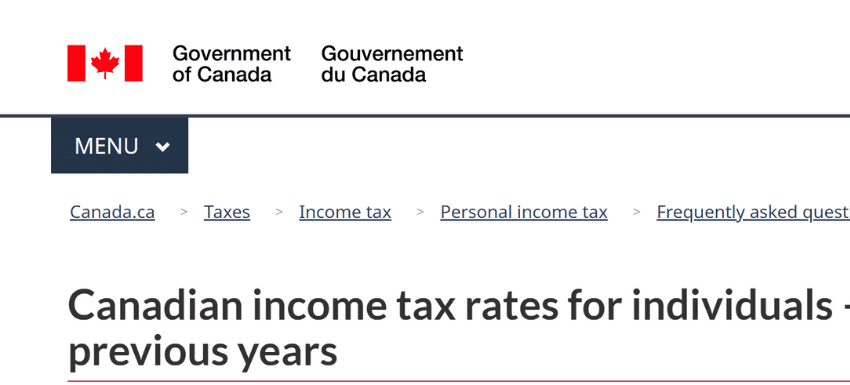
Millions of Canadians have Registered Retirement Savings Plans (RRSPs), which are a great way to save money for retirement while simultaneously lowering taxes. We understand that RRSPs, as much as we love them, can be tough to manage.
What’s an RRSP?
An RRSP is a tax-advantaged account, which means the government developed them particularly to give tax incentives to people who invest in them as a method to encourage them to save for their retirement.
What exactly does the term “tax-advantaged” mean? To you, the Canadian taxpayer, tax benefits equate to “free government money.”
The RRSP is virtually like the CRA saying, “You know what, don’t pay us the tax this year. Pay it off over the following 40 years, when you’ll be paying less in taxes.” People don’t get many opportunities like this, so one should make the most of it!
How does it work?
Every year, you can put money into your RRSP to save for retirement while lowering your tax bill. RRSPs are not tax-free, but they do allow you to defer paying taxes. This implies that you won’t have to pay taxes on the money you put into an RRSP until you withdraw it, which is normally after you retire.
How do I set up an RRSP?

A variety of financial institutions, such as your bank, credit union, trust, insurance company, or financial adviser, can help you set up an RRSP. The issuer’s (the person or institution with which you formed the RRSP) responsibilities include registering the plan, receiving your contributions, and trading the securities held within the plan on your behalf (if appropriate).
What’s the first-60-days rule?
RRSPs are one of the few tax deductions that aren’t connected to the calendar year, unlike most other deductions. In terms of taxes, you have two contribution periods to choose from for each tax year:
- Between March 2 and December 31 of the current tax year; or
- Between January 1 and March 1 of the current calendar year.
This is called the first-60-days rule.
Let’s imagine you’re preparing your tax return for the year 2021. You must state how much money you put into your (or your spouse’s or common-law partner’s) RRSP between March 2 and December 31, 2020, as well as how much money you put in between January 1 and March 1, 2021.
What’s an RRSP deduction limit?
Your RRSP deduction limit is the most you can deduct from your RRSP contributions on your tax return. You can reduce your tax liability by deducting your RRSP contributions (up to your annual deduction limit).
You can find your RRSP deduction limit:
- At the bottom of your latest notice of assessment (NOA) or reassessment;
- By logging in to your CRA My Account (if you’re registered);
- By calling the RRSP Tax Information Phone Service (TIPS) hotline at 1-800-267-6999; or
- On your T1028: Your RRSP Information (in some cases, the CRA will send this form to you if your RRSP deduction limit has changed since you filed your return).
You can choose how much of your annual contributions to deduct from your tax return. If you don’t deduct all of your donations this year, you can save the balance for later. This allows you to spread out your tax savings over a longer period of time.
What’s an RRSP contribution receipt?

To claim the amounts on your taxes, you’ll need the information on your RRSP contribution receipt(s). Your RRSP issuer (for example, your bank) will send you a receipt detailing how much you or your spouse contributed from March 2 to December 31 to the RRSP. You’ll obtain a separate RRSP contribution receipt for the first 60 days of the year if you also made RRSP contributions.
If you haven’t received a copy of your RRSP contribution receipt, contact the account’s issuer.
Can I contribute to my spouse’s RRSP?
Yes! When you contribute to your spouse’s RRSP, it still lowers your Registered Retirement Savings Plan deduction limit, but you get credit for the contributions on your tax return.
If your spouse is in a lower tax band than you, you might consider contributing to their Registered Retirement Savings Plan so that when they withdraw your contribution from their Registered Retirement Savings Plan, they pay less tax. Keep in mind that your spouse must wait at least three years before taking your contribution, or the amount would be taxed based on your earnings (not theirs). If you contribute to your spouse’s Registered Retirement Savings Plan in 2021, for example, they will have to wait until 2024 to take the funds.
What do I do with unused RRSP contributions?

If you made Registered Retirement Savings Plan contributions during the year and reported them on that year’s tax return but didn’t deduct the full amount, you’ll have unused RRSP contributions. You can claim your unused Registered Retirement Savings Plan contributions in a future year to lower your taxes for that year.
You can find your unused Registered Retirement Savings Plan contribution amount on your:
- Notice of assessment (NOA) or notice of reassessment;
- CRA My Account; or
- T1028 form (if your Registered Retirement Savings Plan deduction limit has changed since you filed your last return).
If you’re downloading your information into your return from the CRA’s website using their AFR service, any unused amounts (as well as your Registered Retirement Savings Plan contributions and deduction limit) will automatically download into your return.
What if I forgot to report my RRSP contributions last year?
If you made Registered Retirement Savings Plan contributions in a previous year but didn’t report them, you’ll need to adjust that year’s return to deduct these contributions from your income.
What if I went over my RRSP deduction limit?
If you contribute more than $2,000 over your deduction limit, you’ll have to pay a tax of 1% per month on the amount you over contributed.
You have 90 days after the end of the year to submit the T1-OVP 2020 Individual Tax Return for RRSP, PRPP and SPP Excess Contributions form to the CRA. You’ll use this form to calculate your penalty tax.
You can lower the penalty tax by withdrawing the over-contribution from your bank account and returning it to your Registered Retirement Savings Plan as soon as possible.
If you want your bank to refund your over-contribution without charging the regular tax on RRSP withdrawals, you’ll need to ask the CRA to certify the over-contribution amount by filing a T3012A form right away. It might take some time, so if you don’t want to wait for a T3012A form to be approved by the CRA (which might be the case if the penalty tax is adding up) and if you don’t mind having tax withheld, you can make a regular withdrawal from your Registered Retirement Savings Plan instead.
Although you’ll need to report the amount you took from your Registered Retirement Savings Plan as income when you file your return, you can claim an offsetting deduction so your over-contribution doesn’t raise your taxable income for the year. For example, if the rest of your taxable income this year is $50,000, and your bank refunded $10,000 of an over-contribution to your RRSP, your total taxable income without an offsetting deduction will be $60,000. However, if you claim an offsetting deduction for your over-contribution, this will bring your taxable income back down to $50,000.
You can claim an offsetting deduction by submitting the T746 form when you file, as long as:
- You reasonably expected to claim a deduction for the contribution, either in the year you made the contribution or the year before; and
- You didn’t make the contribution with the plan to withdraw it later and deduct the offset amount.
Can I withdraw from my RRSP before I retire?
Yes! Keep in mind, the money you take out of your Registered Retirement Savings Plan is considered income, so you have to add it to the other income you earned and reported during the year on your return. This means you could find yourself in a different tax bracket and you could have to pay more tax this year than you did last year.
If you withdraw from your Registered Retirement Savings Plan early, you’ll also lose the contribution room you originally used to deposit that amount (meaning the maximum amount you can contribute to your Registered Retirement Savings Plan will permanently be lower by the amount you withdrew).
How are my withdrawals taxed?

Anytime you withdraw money from your RRSP, some of it is taxed at the source, meaning a portion of the money is sent to the CRA before you receive it. The amount you’ll be taxed depends on the amount you withdrew:
- 10% (5% if you’re a Québec resident) if you withdraw up to $5,000;
- 20% (10% if you’re a Québec resident) if you withdraw between $5,001 and $15,000; and
- 30% (15% if you’re a Québec resident) if you withdraw $15,001 or more.
If you’re a resident of Québec, an additional 15% will also be sent to Revenu Québec on top of the federal rates listed above. For example, let’s say you withdraw less than $5,000 from your Registered Retirement Savings Plan. From the amount you withdraw, 20% in total will be withheld as tax (5% is sent to the CRA, and 15% is sent to Revenu Québec).
Can I withdraw from my RRSP without tax penalties?
The Home Buyers Plan (HBP) and Lifelong Learning Plan (LLP) allow you to withdraw funds from your Registered Retirement Savings Plan without tax penalties, as long as they’re paid back within deadline you’re given.
RRSP vs GRSP
Only one letter separates the RRSP from the GRSP, but that one letter could mean a difference of tens, even hundreds of thousands of dollars in retirement. Group are just company-administered RRSPs. And though they have a few disadvantages, like limited investment options and possibly higher fees, they have one extraordinary advantage—employers will often match a portion or even every dollar of your GRSP contribution.
With this this in mind, you might think of your retirement savings as one of those fabulous champagne towers that you’ve never actually seen at any wedding you’ve personally attended. The top cups always get filled first before anything below gets even a drop of champagne. If money is the champagne in this metaphor, the absolute tip top cup should be your employer’s GRSP. That free-for-the-taking employer matching contribution will make an extraordinary difference in terms of compounding gains over the long term. And because you can have your employer withhold funds to deposit directly into your GRSP, not only will you not be tempted to spend that portion of your pay, the money deposited will be pre-tax, meaning that a larger amount of money will get invested right away, versus investing yourself and having to wait six months to a full year to get that money back though a tax refund.
RRSP vs TFSA
Since both TFSAs and RRSPs are phenomenal in their respective ways, this a kind of a Batman vs. Superman question, one that begs the question why you should have an RRSP when a TFSA is similar and has no early withdrawal fees.
Here are a few of the biggest factors to consider:
- If you haven’t contributed much towards your retirement and you happen to have access to a pile of money right now through, say, a bonus, or inheritance, a TFSA might be the best option for you, since RRSPs have what’s called an annual deduction limit, meaning that you won’t be able to deduct over a certain amount in any given year. The number for 2021 is $27,830 but you can find past, current and future deduction limits on this CRA page.
- TFSA are designed to be easily accessed before retirement if the funds are needed—which is good, especially for those with a more immediate goal in mind like buying a house or car. TFSAs are less good if you happen to be the type who’s never been able to resist smashing a piggy bank.
- If the funds are for your retirement, for tax reasons, TFSAs are generally considered preferable to RRSPs for those earning less than $50,000 a year.
Do I Need RRSP?
The answer to this question isn’t found in the back of the book. RRSP is a deeply personal purchase and there are many factors to consider. In addition to considering your current family’s financial needs, you should also account for future expenses like tuition, funeral arrangements, estate taxes, and any other debts you would like settled if you died. (If that sounds complicated, there are insurance calculators).
Thankfully, AG Group Enterprise Ltd, is here to help! Our mission at AG Group is to provide a wide range of Financial and Insurance help, RRSPs, RESPs, and more included!
With AG group’s help, you can protect the future of your family and your finances. A good policy ensures a bright future!



